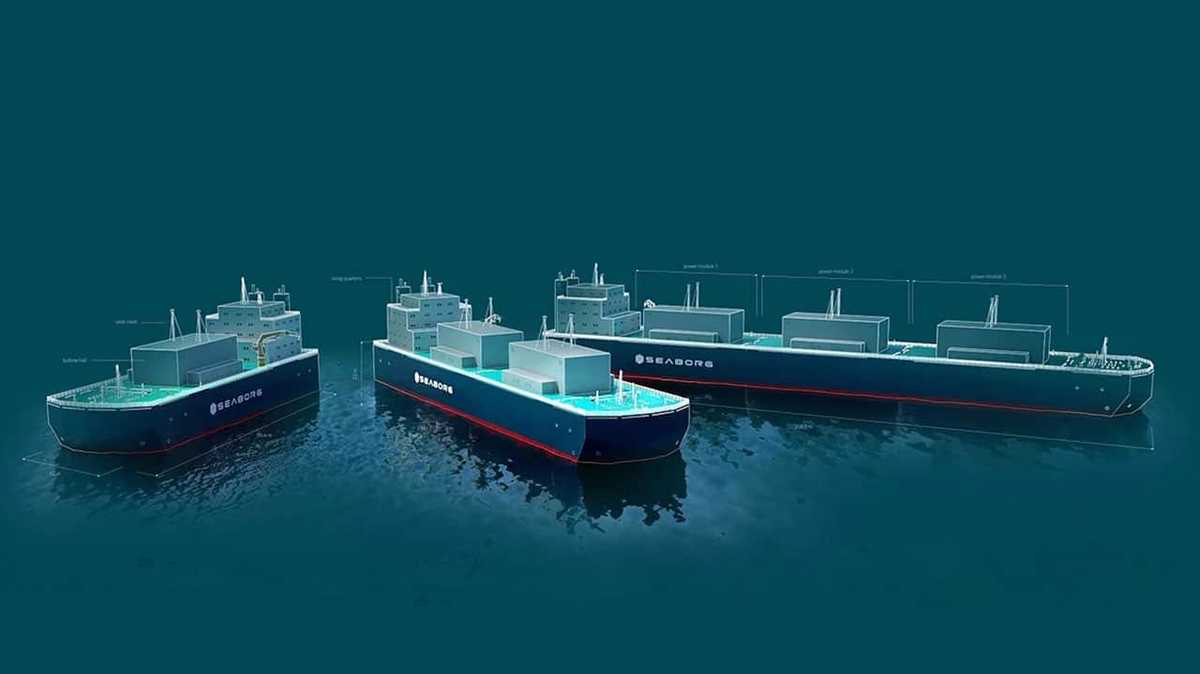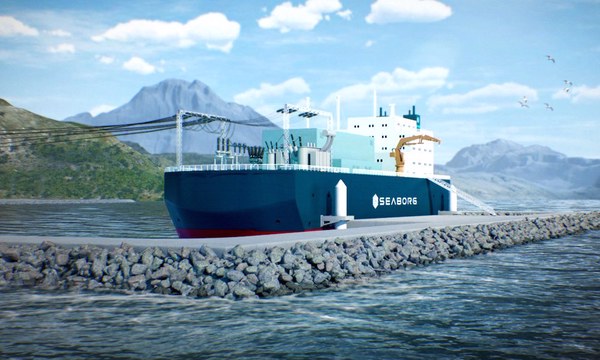Samsung Heavy Industries receives ABS nod for floating offshore nuclear power plant concept
Samsung Heavy Industries is building a floating nuclear power plant that uses compact molten salt reactor (CMSR) technology to supply electrical and thermal energy in partnership with Danish CMSR developer Seaborg Technologies.
 PHOTO: Concept of Seaborg's CMSR Power Barge. Seaborg
PHOTO: Concept of Seaborg's CMSR Power Barge. Seaborg
South Korean shipbuilder Samsung Heavy Industries (SHI) has received a green light from shipping classifier ABS for its conceptual design for a CMSR power barge. In this concept, two to eight of Seaborg’s 100 megawatt (MW) mini molten salt reactors will be mounted on modular power barges built by SHI.
"We will continuously develop technologies for floating nuclear power plants, which will lead a new market," says Yeo Dong-il, head of marine design at SHI.
A molten salt reactor is a nuclear reactor that uses molten salts (high-temperature liquid salts) as a nuclear fuel instead of conventional solid fuels. The reactors are safer and generate less waste than other types of reactors, making them more ideal for marine environments.
According to the World Nuclear Association, in a basic molten salt reactor concept, “the fuel is a molten mixture of lithium and beryllium fluoride salts with dissolved low-enriched uranium fluorides.”
In Seaborg's CMSR, the fuel is mixed with molten fluoride salts, which also serve as coolants. According to Seaborg, if radioactive fuel salt is ever exposed to the atmosphere, it will simply cool down and become solid rock containing all the radioactive material within.
It is also possible to handle radioactive waste using conventional methods since the fuel and fission products are chemically stable, according to Seaborg.
“CMSR is a carbon-free energy source that can efficiently respond to climate change issues and is a next-generation technology,” says Jintaek Jeong, president of SHI. It provides safe and high-efficiency power along with hydrogen production, said Jeong.

PHOTO: Seaborg and SHI will also develop ammonia and hydrogen plants alongside the floating nuclear power plant. Seaborg
Game changer for renewable marine fuel production?
Additionally, SHI and Seaborg will construct hydrogen and ammonia plants alongside the nuclear plant, using the carbon-free energy produced at the floating plant.
“The stable production of energy also offers a fundamental basis for the production of all Power-2-X fuels, where especially hydrogen and ammonia are considered a future energy source to replace traditional fossil fuels,” says Seaborg.
Although the companies have yet to announce whether they intend to produce ammonia and hydrogen specifically for the marine fuels market, these two alternative fuel types have repeatedly been described as the key to decarbonising shipping.
The International Renewable Energy Agency (IRENA) estimates that shipping will require 46 million mt/year of green hydrogen by 2050 to achieve net-zero greenhouse gas (GHG) emissions. According to the agency, 73% of it will be used to produce green ammonia, 17% for green methanol, and 10% for liquid hydrogen to be consumed directly with fuel cells or internal combustion engines. However, a massive scale-up of renewable energy infrastructure will be required to achieve this number.
Although wind and solar energy are strongly advocated by some voices as renewable energy sources to bet on, nuclear energy is starting to gain popularity because of its zero-emission footprint and higher reliability. The US Department of Energy promotes nuclear energy by stating that it has a smaller footprint than solar or wind power, produces less waste, and is far more dispatchable than these two sources.
The Mærsk Mc-Kinney Møller Center for Zero Carbon Shipping (MMMZCS) also pointed out on a report last November that a nuclear-fuelled production facility could be used to produce green ammonia for marine use. It concluded that the nuclear ammonia plants could present an economically sound alternative to wind and solar power in areas with insufficient wind and solar power and constrained land resources.
SHI's floating nuclear power plant could prove to be a dark horse in the race for maritime decarbonisation, especially in light of the urgency to expand green infrastructure for renewable bunker fuels.
Another shipping classification society, Bureau Veritas, is collaborating with nuclear power technology developer ThorCon to deploy a 500 MW molten salt nuclear power barge in Indonesia. South Korean Daewoo Shipbuilding will construct the barge that will hold the nuclear reactor.
Laurent Leblanc, senior vice president of technical and operations at Bureau Veritas has said: "New technologies, such as molten salt reactors, open opportunities for the deployment of nuclear energy, power generation in the marine environment being an example.” The ThorCon project can lead to other nuclear applications like offshore hydrogen generation and nuclear ship propulsion, he said.
By Konica Bhatt
Please get in touch with comments or additional info to news@engine.online





